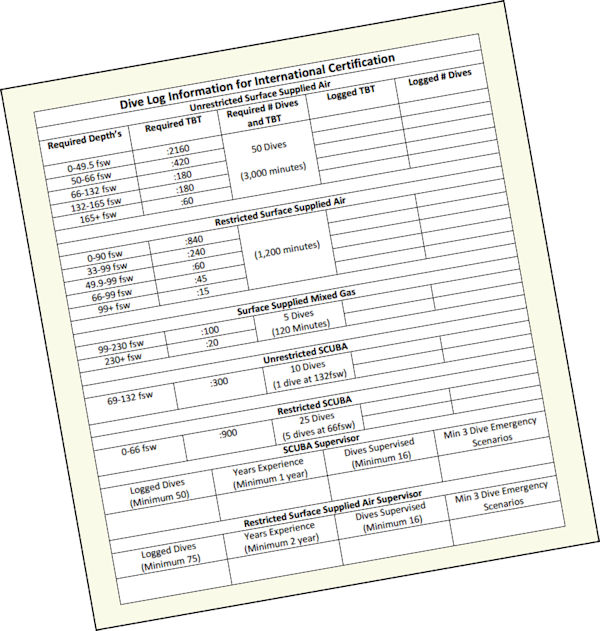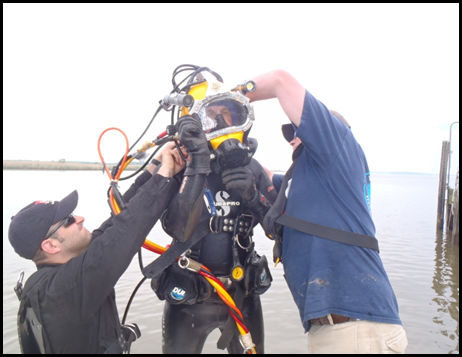Diving Log
30.A.24 For each diver and dive, the following dive log information, as a minimum, must be recorded and maintained at the dive location:
- Full name;
- Date, time and location of dive;
- Maximum depth and bottom time;
- Surface interval between dives;
- Breathing medium and type of equipment used;
- Group classification at the beginning and end of each interval and repetitive dive worksheet;
- Underwater and surface conditions;
- Depth(s) and duration(s) of any decompression stops;
- Date and time of last previous dive if it occurred in the last 24 hours;
- Name of Dive Supervisor(s) during dive;
- General description of work performed; and
- For dives outside the no-decompression limits, deeper than 100 ft salt water (fsw) (30.5m), or using mixed-gas, include depth-time and breathing-gas profiles and decompression tables (including any modifications).
30.A.25 For each dive in which decompression sickness and/or pulmonary barotraumas is suspected or symptoms are evident, the following information must be recorded and maintained:
- Descriptions of signs and symptoms (including depth and time of onset);
- Description and results of treatment; and
- Name, address, and phone number of attending physician.
Pre-Dive Checks
30.A.26 Prior to the dive, the Dive Supervisor must assure, as a minimum, the following pre-dive checks are performed:
- Breathing air tanks contain sufficient air supply to perform the required work (i.e., standby air tanks are on site and full to the necessary capacity);
- All diving equipment must be checked for proper function prior to diver entry;
- All necessary safety equipment specified herein is on site and functioning properly;
- Lockout/tagout procedures are followed;
- When applicable, crane signals are reviewed and radio communication with the crane operator is functioning properly;
- When applicable, welding or cutting procedures are clearly reviewed, the proper welder polarity is set, and precautions have been taken to ensure that electrocution will not occur;
- When applicable, blasting procedures are clearly reviewed and precautions have been taken to ensure unplanned/unscheduled blasts will not occur;
- A pre-dive briefing must be given that includes, but is not limited to, the accident management plan, AHA, equipment checklist, diving logs, diving conditions, and diving procedures;
- When applicable, manbaskets used for diver access must be inspected and load tested prior to use, and a Critical Lift Plan must be submitted per Section 16.H and Section 30.B.06).
30.A.27 Copies of the dive logs must be submitted to the DDC after completion of the dive operation. For USACE dive teams, these records must be maintained on file for two years.
Knowledge Check Choose the best answer for the question.
30-9. For each dive in which decompression sickness and/or pulmonary barotraumas is suspected or symptoms are evident, additional dive log information must be recorded and maintained that includes _____.
You forgot to answer the question!


